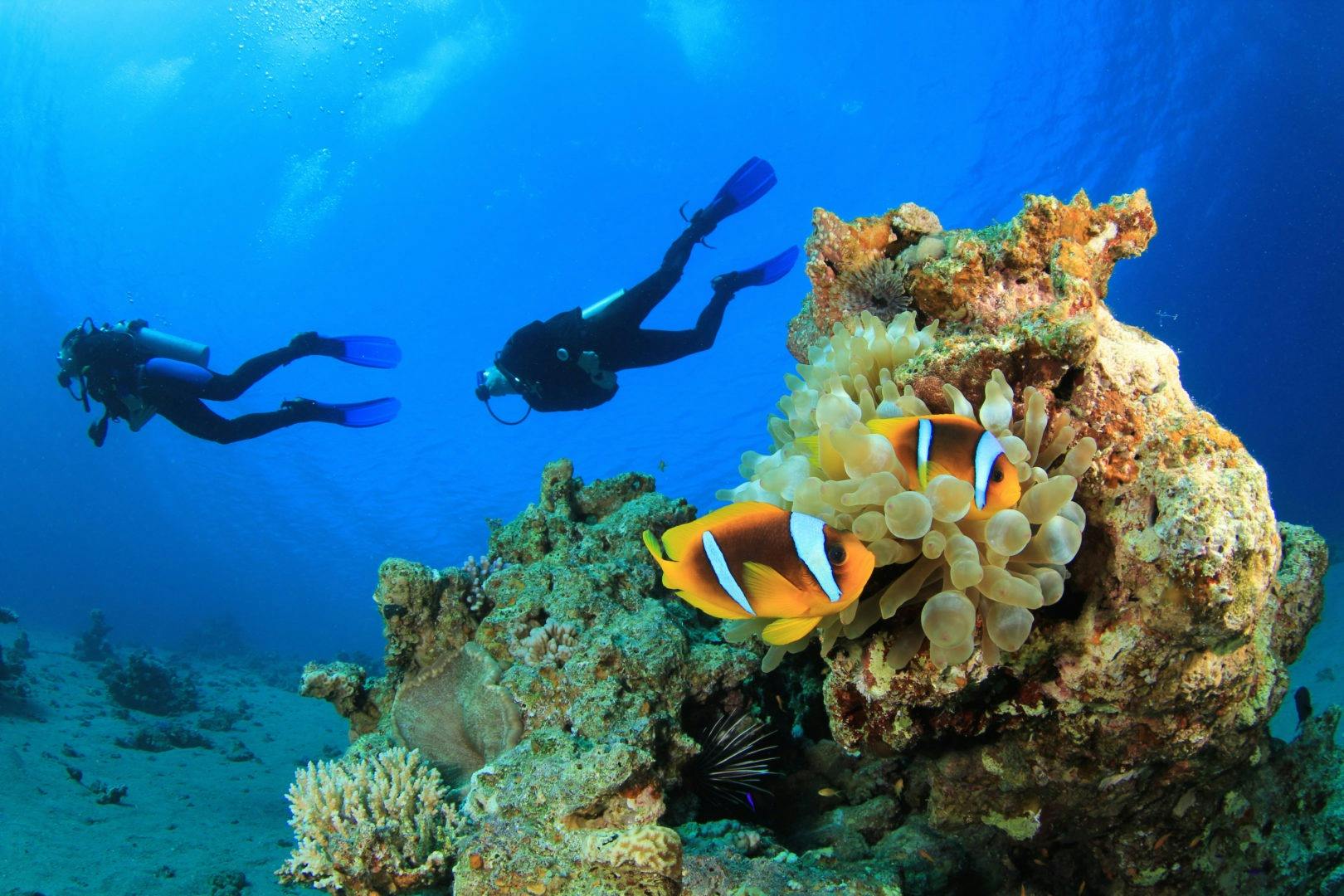- Experiences >
- Destinations >
- Gear >
- About Us >

Scuba Diving and Snorkeling
Diving and snorkeling lets us explore the unique ocean world first hand and come face-to-face with an incredible biodiversity of fish, mammals, corals and seas creatures. With the ocean covering over two thirds of the planet’s surface, there are a huge range of possibilities of where to dive and what can be seen beneath the surface.
It is the tropics where most divers really experience the thrills of the underwater environment. In warm clear waters from the South Pacific to the Caribbean, The Galapagos to Borneo, these adventures will consume your senses and finishing the day at a breath-taking resort makes it even more enjoyable. Even for those who don’t want to take the ‘full plunge’ with scuba diving, snorkeling offers similar experiences very close to the surface – particularly for viewing a kaleidoscope of colours and shapes in expansive coral gardens.
There are a variety of dive tour options including live-aboard vessels, land based resorts, dive and qualification courses, and small dive boat operations. All the operators seek out the best opportunities for sea life viewing, whether it be Manta Rays, Whale Sharks, Turtles, Reef Sharks, Humpback Whales, Humboldt Squid, Fur Seals or Giant Australian Cuttlefish. As Jacques Cousteau said, “the best way to observe a fish is to become one”. Whether you are taking your first dive experience day, or a seasoned dive pro, there are a world of possibilities for where to dive next. Let us show you some of the best!
Experience Types
2 options selected
- All Experiences
- *Gift Voucher*
- 4WD Tours
- Abseiling
- Adventure Journeys
- Aerobatic Flights
- Alpine Hiking
- Ballooning
- Bike Hire
- Bike Tours
- Boat Charters
- Bridge Climb
- Bucket-List Adventures
- Bungy Jumping
- Camel Riding
- Camping
- Canoeing
- Canyoning
- Cars/Go Kart
- Caving
- Courses
- Cruise
- Diving
- Dolphins/ Dolphin Swim
- Eco Tours
- Expedition Cruising
- Fishing
- Fly Board
- Forest / Rainforest
- Geothermal Parks
- Glacier Hiking
- Glowworm Caves
- Hang Gliding
- Heli-skiing & Heli-boarding
- Hiking & Trekking
- Horse Riding
- Hovercraft
- Indigenous & Cultural
- Island Hopping
- Jet Boating
- Jet Ski
- Kayaking
- Kite Surfing
- Live Aboard Diving
- Luge
- Marine Parks / Reserve
- Motorbike Tours
- Motorsports
- Mountain Biking
- Mountaineering and Climbing
- National Parks
- Nature
- Outback
- Packrafting
- Paddle Board
- Paragliding
- Parasailing
- Polar Expeditions
- Quad Biking
- Rafting
- River Cruises
- Rock Climbing
- Safari
- Sailing
- Sand Boarding
- Scenic Flights
- Scenic Tour / Sightseeing
- Self Drive
- Skiing & Snowboarding
- Skydiving
- Skydiving - Indoor
- Skyrail Gondola
- Snorkelling
- Snowshoeing
- Surfing
- Swimming
- Swing
- Training Courses
- Try-It Adventures
- Virtual Experience
- Volcano Tours
- Walking Tours
- Water Sports
- Whale Watching
- Wildlife and Birdwatching
- Ziplining
- Zoos / Wildlife Parks
Destinations
All Destinations
- All Destinations
- Africa
- - Kenya
- - South Africa
- - Tanzania
- Antarctica
- Argentina
- Australia
- - Adelaide
- - Airlie Beach
- - Blue Mountains
- - Brisbane
- - Cairns
- - Gold Coast
- - Melbourne
- - Noosa
- - Port Stephens
- - Rainbow Beach
- - Sydney
- Bhutan
- Canada
- - Revelstoke
- Chile
- Colombia
- Ecuador
- Fiji
- France
- Guatemala
- Iceland
- India
- Indonesia
- - Bali
- - - Ubud
- Japan
- Mexico
- Morocco
- Nepal
- - Kathmandu
- New Zealand
- - Abel Tasman
- - Auckland
- - Bay of Islands
- - Cardrona
- - Charleston
- - Christchurch
- - Coromandel
- - Fox Glacier
- - Franz Josef
- - Greymouth
- - Kaikoura
- - Motueka
- - Mount Cook
- - Paihia
- - Queenstown
- - Raglan
- - Rotorua
- - Taihape
- - Taupō
- - Tauranga
- - Te Anau and Milford Sound
- - Tongariro National Park
- - Turangi
- - Twizel
- - Waiheke Island
- - Waitomo
- - Wanaka
- - Wellington
- Nicaragua
- Pacific
- Pakistan
- Patagonia
- Peru
- Philippines
- Portugal
- Russia
- Sri Lanka
- - Colombo
- United States of America
Durations
All Durations
- All Durations
- Under Full-Day
- Full-Day
- Multi-Day
Booking Type
All Booking Types
- All Booking Types
- Instant Booking
- Enquiry Booking
Finding your next adventure...